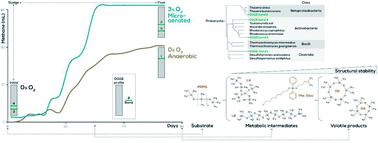当前位置:
X-MOL 学术
›
Environ. Sci.: Processes Impacts
›
论文详情
Our official English website, www.x-mol.net, welcomes your
feedback! (Note: you will need to create a separate account there.)
Microaerobic conditions in anaerobic sludge promote changes in bacterial composition favouring biodegradation of polymeric siloxanes
Environmental Science: Processes & Impacts ( IF 4.3 ) Pub Date : 2021-07-20 , DOI: 10.1039/d1em00143d A E Ortiz-Ardila 1 , B Díez , C Celis , P Jenicek , R Labatut
Environmental Science: Processes & Impacts ( IF 4.3 ) Pub Date : 2021-07-20 , DOI: 10.1039/d1em00143d A E Ortiz-Ardila 1 , B Díez , C Celis , P Jenicek , R Labatut
Affiliation

|
Volatile organic silicon compounds (VOSiC) are harmful pollutants to the biota and ecological dynamics as well as biogas-based energy conversion systems. However, there is a lack of understanding regarding the source of VOSiCs in biogas, especially arising from the biochemical conversion of siloxane polymers such as polydimethylsiloxanes (PDMS). The biodegradation of PDMS was evaluated under anaerobic/microaerobic conditions (PO2 = 0, 1, 3, 5%), using wastewater treatment plant (WWTP) sludge as an inoculum and PDMS as a co-substrate (0, 50, 100, 500 ppm). On average, strictly anaerobic treatments produced significantly less methane than the 3 and 5% microaerated ones, which show the highest PMDS biodegradation at 50 ppm. Thauera sp. and Rhodococcus sp. related phylotypes were identified as the most abundant bacterial groups in microaerated treatments, and siloxane-related molecules were identified as remnants of PDMS catabolism. Our study demonstrates that microaeration promotes changes to the native bacterial community which favour the biological degradation of PDMS. This confirms that the presence of VOSiC (e.g., D4–D6) in biogas is not only due to its direct input in wastewaters, but also to the PDMS microbial catabolism. Microaerobic conditions enhance both PDMS and (subsequent) VOSiC degradation in the liquid phase, increasing the concentrations of D4 and D5 in biogas, and the production of less toxic siloxane-based derivatives in the liquid phase. This study suggests that microaeration of the anaerobic sludge can significantly decrease the concentration of PDMSs in the WWTP effluent. However, for WWTPs to become effective barriers for the emission of these ecotoxic contaminants to the environment, such a strategy needs to be coupled with an efficient biodegradation of VOSiCs from the biogas.
中文翻译:

厌氧污泥中的微需氧条件促进细菌组成的变化,有利于聚合硅氧烷的生物降解
挥发性有机硅化合物 (VOSiC) 是对生物群和生态动态以及基于沼气的能量转换系统的有害污染物。然而,人们对沼气中 VOSiCs 的来源缺乏了解,尤其是由聚二甲基硅氧烷 (PDMS) 等硅氧烷聚合物的生化转化引起的。在厌氧/微需氧条件下(P O 2 = 0, 1, 3, 5%),使用污水处理厂(WWTP)污泥作为接种物和PDMS作为共底物(0, 50, 100 , 500 ppm)。平均而言,严格厌氧处理产生的甲烷明显少于 3% 和 5% 微曝气处理,后者在 50 ppm 时显示出最高的 PMDS 生物降解。Thauera sp. 和红球菌属 相关系统发育型被鉴定为微曝气处理中最丰富的细菌群,而硅氧烷相关分子被鉴定为 PDMS 分解代谢的残余物。我们的研究表明,微曝气促进了有利于 PDMS 生物降解的天然细菌群落的变化。这证实了 VOSiC 的存在(例如, D4–D6) 在沼气中的直接输入不仅是由于其直接输入废水,还因为 PDMS 微生物分解代谢。微需氧条件增强了液相中的 PDMS 和(随后的)VOSiC 降解,增加了沼气中 D4 和 D5 的浓度,以及液相中毒性较低的硅氧烷基衍生物的产生。这项研究表明,厌氧污泥的微曝气可以显着降低污水处理厂流出物中 PDMS 的浓度。然而,要使污水处理厂成为将这些生态毒性污染物排放到环境中的有效屏障,这种策略需要与沼气中 VOSiC 的有效生物降解相结合。
更新日期:2021-07-24
中文翻译:

厌氧污泥中的微需氧条件促进细菌组成的变化,有利于聚合硅氧烷的生物降解
挥发性有机硅化合物 (VOSiC) 是对生物群和生态动态以及基于沼气的能量转换系统的有害污染物。然而,人们对沼气中 VOSiCs 的来源缺乏了解,尤其是由聚二甲基硅氧烷 (PDMS) 等硅氧烷聚合物的生化转化引起的。在厌氧/微需氧条件下(P O 2 = 0, 1, 3, 5%),使用污水处理厂(WWTP)污泥作为接种物和PDMS作为共底物(0, 50, 100 , 500 ppm)。平均而言,严格厌氧处理产生的甲烷明显少于 3% 和 5% 微曝气处理,后者在 50 ppm 时显示出最高的 PMDS 生物降解。Thauera sp. 和红球菌属 相关系统发育型被鉴定为微曝气处理中最丰富的细菌群,而硅氧烷相关分子被鉴定为 PDMS 分解代谢的残余物。我们的研究表明,微曝气促进了有利于 PDMS 生物降解的天然细菌群落的变化。这证实了 VOSiC 的存在(例如, D4–D6) 在沼气中的直接输入不仅是由于其直接输入废水,还因为 PDMS 微生物分解代谢。微需氧条件增强了液相中的 PDMS 和(随后的)VOSiC 降解,增加了沼气中 D4 和 D5 的浓度,以及液相中毒性较低的硅氧烷基衍生物的产生。这项研究表明,厌氧污泥的微曝气可以显着降低污水处理厂流出物中 PDMS 的浓度。然而,要使污水处理厂成为将这些生态毒性污染物排放到环境中的有效屏障,这种策略需要与沼气中 VOSiC 的有效生物降解相结合。











































 京公网安备 11010802027423号
京公网安备 11010802027423号